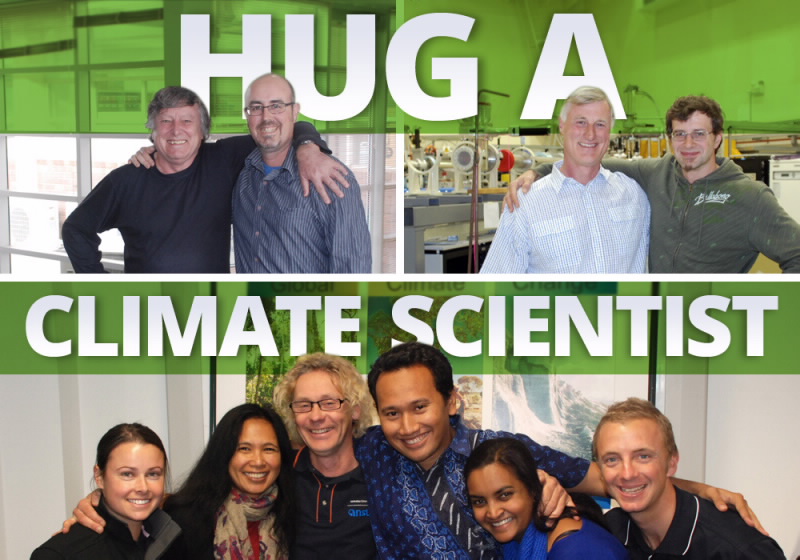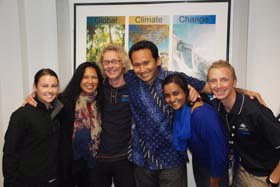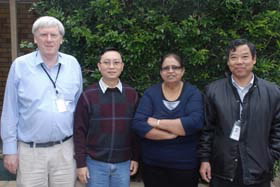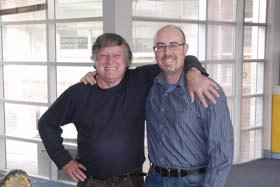Scientists from ANSTO are lining up to share the love on Hug a Climate Scientist Day. Hug a Climate Scientist Day was inaugurated in 2011 by the crikey.com.au website with the worthy aim of encouraging the public to engage with climate scientists.
 |
ANSTO’s Institute for Environmental Research is one of the nation’s key climate research organisations, taking part in a range of important studies into climate science using the Organisation’s landmark infrastructure to measure samples.
ANSTO houses state of the art facilities such as the ITRAX – Corescanner, a key piece of equipment used to measure environmental samples and the only one of its kind in Australia, and super-sensitive accelerators that are capable of detecting elements down to parts per trillion.
Tiny changes in air bubbles found in ice cores, the flows of water in underground reserves, fine particulates found on air filters, and elements in samples in mud from the bottom of lakes are all providing clear messages about the impact of humans on the environment.
ANSTO has a panel of distinguished scientists ready and waiting for their hugs including one of Australia’s foremost experts in the air we breathe, Dr David Cohen; an expert in outback water resources, Dr Dioni Cendon; and Dr Quan Hua, whose studies into Antarctic moss are demonstrating how vegetation is responding to climate change.
Members of the public can give their virtual hugs to our scientists via our official Facebook page.
Profile of a climate scientist
 |
| (L-R) Dr David Cohen gets a hug from Dr Zeljko Pastuovic for his work using nuclear science techniques to study air pollution |
Name: Dr David Cohen
Position: Senior Principal Research Scientist
Qualifications: BSc (Hons), MSc and PhD in Physics
Expertise: Over 35 years of experience in nuclear and atomic physics, materials science, archaeometry, biology and environmental studies
Seeking: A better understanding of the sources of fine particle air pollution and their impacts on human health.
Recent achievements: Tracking pollution in Asia...
The links between fine-particle pollution and public health risks are well documented, which is why it is so important to get a good understanding of what pollution is, where it comes from and how it migrates across countries.
David, along with researchers at ANSTO, has been studying fine-particle pollution in Asia, where the air quality is generally very poor compared with internationally accepted levels.
Using ANSTO’s ANTARES and STAR accelerators, the team not only characterise fine-particle pollution, but also to identify its sources across 15 countries in the region — essentially tracking the pollution across Asia back to its point of origin.
Data collected in Asia will help David and the team better understand how pollution travels through the air, pinpoint more specific links between health issues and poor air quality, and inform research across the world.
Learn more about Dr Cohen's research:
- Size resolved mass chemical properties of dust aerosols from Australia's Lake Eyre Basin
- Long range transport of fine particle windblown soils and coal fired power station emissions into Hanoi between 2001 to 2008
 |
| Professor Henk Heijnis (third from left) feeling the love from his research team for his work tracing human impacts on earth systems |
Name: Adjunct Professor Henk Heijnis
Position: Senior Principal Research Scientist
Qualifications: BSc in Physical Geography, MSc in Quaternary Geology and Lowland genesis and a PhD in Applied Physics
Expertise: Over 25 years of experience in geoscience with key interests in Antarctica, SE Asia, Australasia and the Eastern Pacific
Seeking: For our research team it is important to find out the relative contributions of direct human impact on a changing climate and natural climate variability and change.
We see much more rapid response and detrimental effects on the earth’s surface today , then we reconstructed a few hundreds of years ago. Human activity in tandem with human induced climate change is a very powerful negative force and will have long lasting effects on the earth’s surface.
Recent achievements: As the Leader of ANSTO’s Nuclear Methods in Earth Systems Project, Henk takes part in research into tracing human impacts.
Knowledge of when - and to what extent - humans have altered the Earth's surface is vital in understanding current problems in land and water management.
The 'Tracing human impacts on Earth systems' task aims to sort human-induced change from natural responses to external forces and ecosystem dynamics.
The main objective is to study natural archives of climate and environmental change in the Asian and Australasian regions and to use environmental isotopes (such as 210Pb, 137Cs, 7Be, 14C and 239Pu) to provide a temporal framework.
Learn more about Professor Heijnis' research:
 |
| Dr Quan Hua (second from left) with comrades from ANSTO's environment institute ready to feel the love for hug a climate change scientist day |
Name: Dr Quan Hua
Position: Senior Research Scientist
Qualifications: BSc Nuclear Physics and PhD in Radiocarbon and Earth Sciences
Expertise: Over 15 years of experience in radiocarbon dating and its applications to Quaternary and climate change studies
Seeking: To leave a planet in a clean and healthy way that can be enjoyed by generations of people to come
Recent achievements: Moss reveals biological effects of climate change...
One of the few remaining untouched species on the planet is the moss of Antarctica. Research into this humble moss could provide a better understanding of how vegetation responds to future climate change.
Studies by Quan and a team of researchers from ANSTO and the University of Wollongong on Antarctic moss shoots suggest the plant species has shown symptoms of being affected by changes in climate.
Through radiocarbon dating and measuring the depth of moss colonies, considered to be the ‘old growth forests’ of Antarctica in miniature, the scientists observed that the moss growth at some sites has declined since the 1980s.
They suggest that this is likely due to moss beds drying out, which appears to be caused by increased wind speeds possibly linked to the Antarctic ozone hole. The results also show that climate change has made the driest continent on Earth an even harsher environment for plant life.
Learn more about Dr Hua's research:
- Radiocarbon dating of tree rings to understand climate change
- Miniature Antarctic forests give us a glimpse at future climate change
 |
| (L-R) Professor John Dodson giving Dr Dioni Cendon a hug for all his work on ground water |
Name: Dr Dioni Cendon
Position: Research Scientist
Qualifications: BSc Geology, PhD Geochemistry
Expertise: Over 20 years of experience in hydrogeochemistry of surface, groundwaters and evaporitic deposits, stable isotope geochemistry and analytical techniques
Seeking: Better awareness and study of our precious groundwater resources, they cannot be taken for granted!
Recent achievements: Fresh water uncovered in outback Australia...
Australia is the driest inhabited continent on Earth. Both rain and surface water in inland Australia can be unreliable and scarce, and that’s why shallow fresh and shallow underground water is critical to support vegetation in our inland environment.
Using ANSTO’s tandem particle accelerator, Dioni and a team of researchers from ANSTO and the Universities of Wollongong, Southern Queensland and Barcelona have discovered fresh underground water ‘lenses’ on the Cooper Creek in outback Queensland, which provides insight into how ecosystems along our dry-land rivers are sustained.
The study of these freshwater lenses will help the team better understand environmental sustainability issues around Australia’s arid rivers, and could have significant implications for land management.
Learn more about Dr Cendon's research:
Published: 12/06/2013


